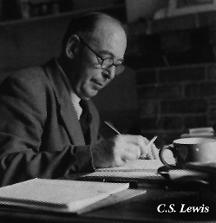
The Final Victory
That Hideous Strength explores the scientific side of the theological struggle presented in the first two books of the trilogy. The NICE represent all that was misguided about Dr. Weston, only this time they have unlimited backing and high technology to follow their dark intentions. The dichotomy between good and evil is at its greatest in this final novel. The dark, faceless bureaucracy of the NICE with its disembodied Head spouting the words of the devil is about the most clear cut vision of evil that can be imagined.
In contrast, the spiritually enlightened Ransom leading a group of the followers of Maleldil and incorporating the legend of the heroic King Arthur represents the polar opposite of the power-hungry NICE. The notion of the resurrected Merlin is the bridge between the two sides. Medieval magic has a kind of mysterious aura that can be interpreted both as holy and, at the same time, blasphemous. Lewis uses this perception to create tension during the push to find and resurrect the ancient magician. If the NICE gain control of Merlin, it is clear that the outcome will involve the darker side of this magic, whereas if Logress is able to intercept him and draw him into their circle, Maleldil is sure to use Merlin’s powers for good.
The fact that Ransom turns out to be the Pendragon is also symbolic of the change ordinary people can undergo when serving a higher power. Ransom’s complete transformation from the philologist to the mythical English savior is an extension of the kind of underdog heroics that Lewis and Tolkien both used extensively throughout their fiction. Along this same line, the decision to make Mark Studdock the protagonist may seem bizarre, but it allows the reader to learn of the NICE from a man who is at the same time connected to and repulsed by the organization. The fact that his wife is working for the group that is out to foil the NICE’s plans adds another dimension to the story.
As the final book of the trilogy, That Hideous Strength is the culmination of the themes set up in the first two novels. Its reliance on legend would ordinarily make the book too fantastic to carry a serious theological message, but Lewis’s masterful style avoids this risk completely. Lewis’s trilogy is the premier work of theological science fiction in the 20 th century, and will doubtless continue to have a powerful impact on future generations of readers.
